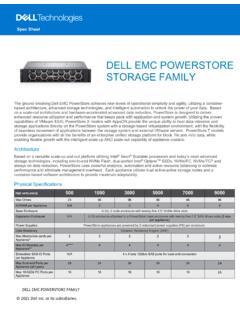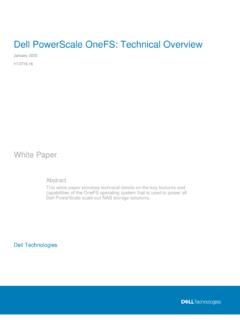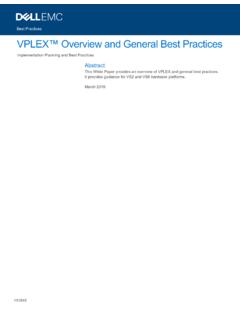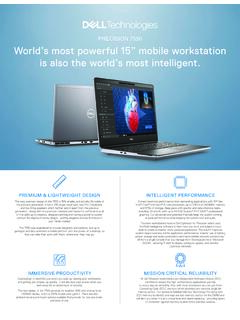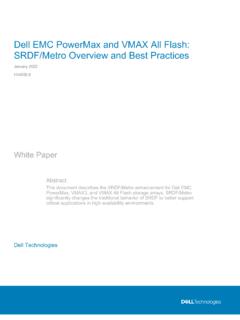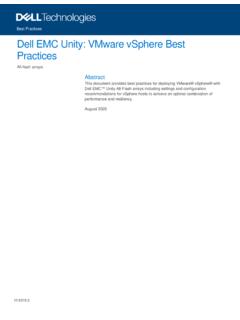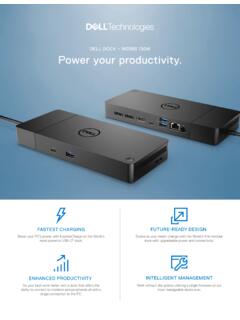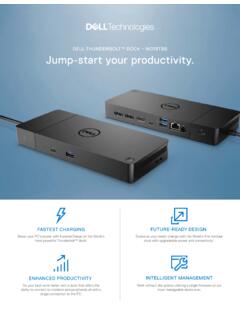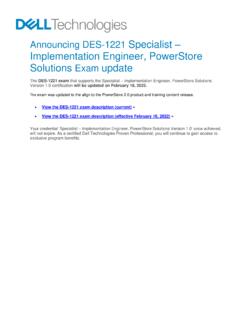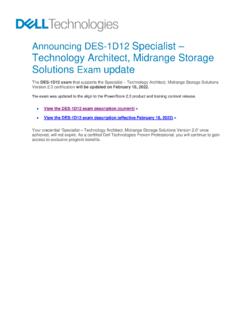Transcription of Dell PowerStore: Introduction to the Platform
1 Dell powerstore : Introduction to the Platform January 2022 White Paper Abstract This white paper provides an overview of the powerstore Platform . It details the value proposition, architecture, and various deployment considerations of the available powerstore appliances. Dell Technologies Copyright 2 Dell powerstore : Introduction to the Platform The information in this publication is provided as is. Dell Inc. makes no representations or warranties of any kind with respect to the information in this publication, and specifically disclaims implied warranties of merchantability or fitness for a particular purpose. Use, copying, and distribution of any software described in this publication requires an applicable software license. Copyright 2020-2022 Dell Inc. or its subsidiaries. All Rights Reserved. Dell Technologies, Dell, EMC, Dell EMC and other trademarks are trademarks of Dell Inc.
2 Or its subsidiaries. Intel, the Intel logo, the Intel Inside logo and Xeon are trademarks of Intel Corporation in the and/or other countries. Other trademarks may be trademarks of their respective owners. Published in the USA January 2022 Dell Inc. believes the information in this document is accurate as of its publication date. The information is subject to change without notice. Contents 3 Dell powerstore : Introduction to the Platform Contents Executive summary .. 4 Introduction .. 5 powerstore overview .. 8 Hardware overview .. 9 powerstore T models .. 26 powerstore X models .. 32 Conclusion .. 37 References .. 38 Executive summary 4 Dell powerstore : Introduction to the Platform Executive summary Dell powerstore is designed with two purpose-built platforms. The 2U, two-node, dual-socket Intel Xeon Platform is used for the powerstore 1000, 3000, 5000, 7000, and 9000 models.
3 The 2U, two-node single-socket Intel Xeon Platform is used for the powerstore 500 model. powerstore provides a data-centric, intelligent, and adaptable infrastructure that supports both traditional and modern workloads. This white paper details the hardware Platform , drives, and various physical components. This document includes cabling and deployment guidance for all powerstore model appliances. This document is intended for IT administrators, storage architects, partners, and Dell Technologies employees. The audience also includes any individuals who may evaluate, acquire, manage, operate, or design a Dell networked storage environment using powerstore systems. Date Description April 2020 Initial release: PowerStoreOS September 2020 Minor updates December 2020 PowerStoreOS updates: Discovery through static IP January 2021 Hardware overview and Metro node updates April 2021 PowerStoreOS updates June 2021 Minor updates January 2022 PowerStoreOS updates; template update Dell Technologies and the authors of this document welcome your feedback on this document.
4 Contact the Dell Technologies team by email. Author: Ethan Stokes Note: For links to other documentation for this topic, see the powerstore Info Hub. Overview Audience Revisions We value your feedback Introduction 5 Dell powerstore : Introduction to the Platform Introduction In this constantly changing world of increasing complexity and scale, the need for an easy-to-use, intelligent storage system has only grown greater. Organizations that use new applications and solutions require dependable storage and often face the challenge of doing more with less. powerstore addresses this challenge by packaging a powerful storage system into a cost-efficient and space-efficient profile. Key powerstore features and benefits include: Active/active architecture: powerstore uses both nodes to serve host I/O and run data operations in an active/active manner. This design efficiently uses all available hardware resources and optimizes performance, cost, and density in data centers.
5 NVMe Platform : powerstore is designed to use the latest storage and interface technologies to maximize application performance and eliminate bottlenecks. powerstore can maximize performance with NVMe flash storage and supports Intel Optane storage class memory (SCM) which approaches the speed of DRAM. powerstore supports front-end NVMe connectivity with NVMe over Fibre Channel and NVMe over TCP, for a complete end-to-end NVMe solution. AppsON: Integration of the powerstore container-based architecture with onboard VMware ESXi results in a new level of consolidation for enterprise storage. This consolidation provides the benefits of a local, on-array application environment and integrates with the VMware vSphere management environment and server resources. This ability allows users to bring applications closer to storage by running applications as virtual machines that run directly on powerstore .
6 AppsON enables agility for application deployments and allows seamless movement between the powerstore appliances and VMware ESXi servers. It also helps reduce the server and networking footprint for space-efficient edge and remote deployments. Complemented by joint engineering work with VMware and Intel, AppsON uses intellectual property to bypass the hypervisor. This ability enables bare-metal NVMe performance with full support for plug-and-play functionality and PCIe fault containment. VMware integration: powerstore is designed to have deep integration with VMware vSphere including VAAI, VASA, event notifications, snapshot management, VMware vSphere Virtual Volumes (vVols), and virtual machine discovery and monitoring in powerstore Manager. Unified offering: powerstore has a single architecture for block, file, and vVols. This architecture uses the latest technologies to provide flexible functionality without sacrificing the cost-effective nature of enterprise storage.
7 powerstore provides storage in multiple formats to applications, ranging from physical and virtual volumes to containers and traditional files. This ability provides the ultimate workload flexibility and enables IT to simplify and consolidate infrastructure. A modern, simple interface: powerstore Manager, the powerstore management interface, is built with the data-center administrator in mind. Using browser-native HTML5, powerstore Manager can be used across various operating systems and web browsers without requiring an external management server or appliance. Inline data reduction: Data reduction technologies play a critical role in environments in which storage administrators are attempting to do more with less. powerstore key features Introduction 6 Dell powerstore : Introduction to the Platform powerstore data reduction supports this effort by optimally reducing the amount of physical storage that is required to save a dataset.
8 powerstore data reduction provides space savings by using software data deduplication and compression through hardware assist. The storage system always enables and intelligently controls data reduction. Native data protection: Security and availability of data are critical concerns for many organizations, and powerstore storage offers multiple solutions to address this need. Snapshots provide point-in-time copies of block, file, and virtual machine data that can be used for backup and restoration purposes. Asynchronous replication offers an IP-based replication strategy within a system or between two systems. Data at Rest Encryption (D@RE) ensures that user data on the system is protected from physical theft and can substitute drive disposal processes, such as shredding. The following table provides definitions for some of the terms that are used in this document.
9 Table 1. Terminology Term Definition Appliance Solution containing a base enclosure and any attached expansion enclosures. The size of an appliance could be only the base enclosure or the base enclosure plus expansion enclosures. Base enclosure Enclosure containing both nodes (node A and node B) and 25 x NVMe drive slots Cluster One or more appliances in a single grouping and management interface. Clusters are expandable by adding more appliances to the existing cluster, up to the allowed amount for a cluster. Expansion enclosure Enclosures that can be attached to a base enclosure to provide additional storage. Fibre Channel (FC) protocol Protocol used to perform IP and SCSI commands over a Fibre Channel network. File system Storage resource that can be accessed through file-sharing protocols such as SMB or NFS. iSCSI Provides a mechanism for accessing block-level data storage over network connections.
10 Network-attached storage (NAS) server File-level storage server used to host file systems. A NAS server is required to create file systems that use SMB or NFS shares. Network File System (NFS) An access protocol that allows data access from Linux or UNIX hosts on a network. Node Storage controller that provides the processing resources for performing storage operations and servicing I/O between storage and hosts. Each powerstore appliance contains two nodes. NVMe over Fibre Channel (NVMe/FC) Protocol used to perform Non-Volatile Memory Express (NVMe) commands over a Fibre Channel network. Terminology Introduction 7 Dell powerstore : Introduction to the Platform Term Definition NVMe over TCP (NVMe/TCP) Protocol used to perform Non-Volatile Memory Express (NVMe) commands over an Ethernet network. powerstore Command Line Interface (PSTCLI) Interface that allows a user to perform tasks on the storage system by typing commands instead of using the user interface.
